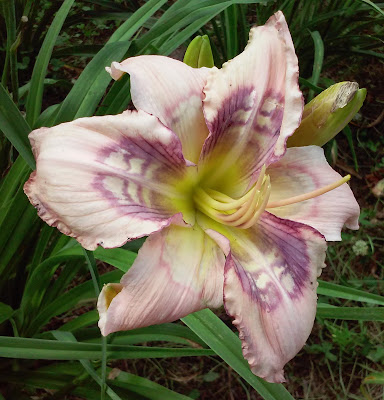Base Plants:
The Tertiary Layer
I have added an update to the end of this article, as I have had numerous requests to give an example of how I work with a tertiary plant within my program.
In this layer we see all the fanciest flowers. Unfortunately, those fanciest flowers also far too often come on the worst or most tender plants, so the problem becomes - how to bring in those very advanced flower trait without ending up with tender plants. Now, before I begin to answer that, I want to stress that not every plant at the tertiary level is a bad plant or is tender.
All hybrid cultivars from other hybridizers enter my program as a tertiary level plant. Some plants are tertiary because of their foliage type, which is not a flaw, but I am aiming for a specific range of foliage behaviors so tender foliage can rule a plant out for my needs. Some will turn out to be good plants and pretty flowers, maybe even have an exceptional trait or two and move up to the secondary layer, but the hard truth is that the majority of plants that I bring in and test remain at the tertiary level, if they ever get used in breeding, contribute anything to my program, or even remain in my garden at all. I want to be honest, in terms of both the good and the bad, and there is always some of both.
I want to define, in the broadest terms, what a tertiary plant is in my program. The tertiary plants in my program are plants that have contributed genetic material into my program, but that I would not in any way consider using in any form of inbreeding, backcrossing or sibling mating, and I make the greatest effort to ensure I would rarely blend plants from later generations with a tertiary plant in its background, so as to avoid any type of inbreeding with these ancestors. Most tertiary plants do not remain in the program or the garden, except in rare instances.
One example is Wow! Factor, which is a pretty good plant, and I have used its pollen and have good seedlings from it. However, it has low rust resistance and over six years has only set two pods. I would NEVER inbreed back to it, but I like it and so it is still here, and I will use the pollen in certain ways at times, last using it in the 2019 season on multiple toothy types. I consider it a tertiary (+) cultivar.
This level demonstrates an aspect of breeding that can be disheartening, but is important. It is important to keep your goals in mind and not be distracted by pretty faces growing out of empty packages. That doesn't mean you can't make use of these less than ideal plants that have a flower trait, though, and this level of my program can serve as a roadmap for those who want to use a particular cultivar, but are not satisfied with it on many levels. Basically, you just want to dip in, get a little bit of its genes and then carry them out into more reliable lines, working to extract the traits you want, while eliminating the traits you don't want.
I treat all new plants as tertiary until they have proven otherwise. Only a few do, but once they have proven themselves over several years, both in the garden and the seedling bed, then they move on into the secondary level where they may be used repeatedly, are maintained the program and might even get inbred, if there seems to be enough good traits to seek to concentrate them.
I will likely always have a few new plants, tertiary until proven otherwise, that are being tested in my garden.
________________________________________________
In the next installment, we will look at the seedlings I have produced from the four species/species-like bases and the secondary level plants - those selects that have become my own base plants and some that have made it to introduction.






